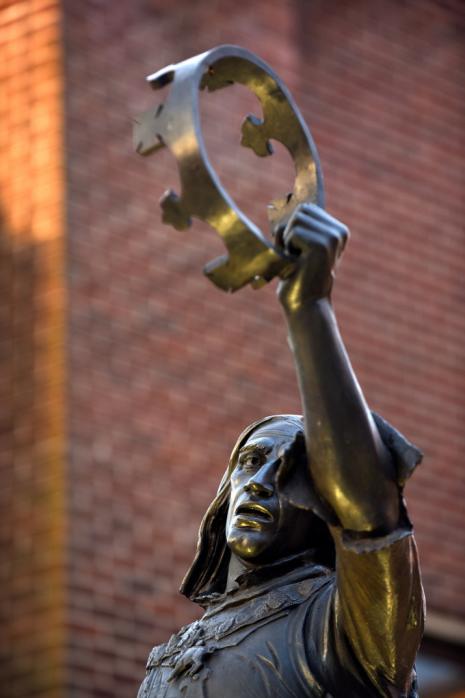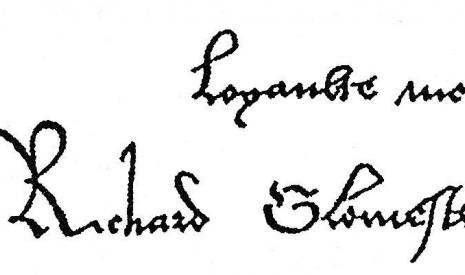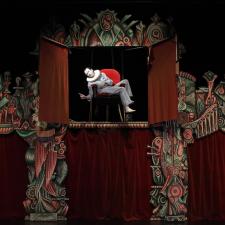
Richard III – Loyaulté me lie # 14
Emblem and motto (1/2)
For the real Richard III, King of England and Lord of Ireland, recently buried in Leicester, “Loyaulté me lie” is more than just a motto. In those feudal times, loyalty was an unavoidable value of the knightly code of honour. Richard, then Duke of Gloucester, chose this motto and made it the foundation of each of his actions.
The motto was written in French, because Old French and Latin were then, in England, the languages used by high society, justice and the court. This is the reason why, on Richard’s flag, the motto is written in Old French, with an additional l added to the word Loyaulté.
For Richard, this is also the sign of an official commitment influenced by real-life decisions. Contrary to what we might think – partly informed by the image we have been given of Richard as a Machiavellian, deceitful, treacherous and selfish tyrant – he was always loyal to those he valued and whom he could trust regardless of the circumstances. Since he was a child, Richard supported his older brother Edward IV, whom he really valued. When, very young, he picked this motto, it was to seal the loyalty between the two of them. Since his victory against the Lancastrians at Towton in 1461, Richard saw his brother as a hero. Although then very young, he devoted himself to supporting his brother in his conquest of the crown of England in 1471. Richard III is supposed to have said, at a very young age: “Yet he took care to watch over his brothers and sister, regaling them with tales of his adventures, warming them with his affection and his greatness. How could there be any better than to follow forever and to serve this wonderful brother, so splendid, so kind?”1 He continued to serve and protect him until his death.
In 1483, Edward IV dies. His eldest son, the young Edward V, who is also Richard’s nephew, is put under Richard’s protection, in accordance with Edward IV’s last wishes and what he expected of his brother. Richard wrote to the Queen and to the Council, and under oath, asserted his loyalty towards his nephew. He then genuinely worked towards his enthronement.

Richard is shown as a lame and hideous hunchback. Thanks to scientific evidence, we know now that he did indeed suffer from scoliosis, but that his spine wasn’t curved like the one of a hunchback. Instead, it was asymmetrical, with the right shoulder higher than the left one. A reconstitution of his face, enabled by 3D scans, shows that he wasn’t particularly monstrous or hideous. History has it that he locked away his nephews and had them assassinated, but historical sources are muddled and contradictory, and there is still nothing, five centuries later, that confirms this legend. Shakespeare’s play continues to promote Richard III’s bad reputation. However, written a century after the King’s death at the Battle of Bosworth, it is possible to imagine that it would have been built on rumours, entirely designed by the Tudors and especially Elizabeth I to damage the reputation of Richard III throughout the centuries. What is historically known is that Richard wanted to control the situation so that it could have a conventional outcome, in accordance with his older brother’s wishes. Shakespeare’s play gives us a pleasurable opportunity to play with this ambiguity: confronting the historical character of Richard III and the theatrical character invented by Shakespeare. This way, we might understand how the ghost of this King of England has become the attractive and repellent figure of the conquest of power.

This is why we decided to add King Richard’s motto to the title of our adaptation of Shakespeare’s play. It is a way to, first of all, admit that even though we didn’t add anything to Sheakespeare’s text, we aren’t performing the play in its entirety. This is also to testify that we work and progress together, united by one same value: loyalty, that binds us to theatre, to the audience, to the actors, to Shakespeare’s text and to the magic of his imagination.
* « il a pris soin de veiller sur ses frères et sœurs, les régaler avec des histoires de ses aventures, les réchauffer avec son affection et de sa grandeur. Comment pourrait-il y avoir quelque chose de mieux que de suivre toujours et pour servir ce merveilleux frère, si splendide, si gentil » Richard III – biographie par Paul Murray Kendall p.38
- Richard III – Loyaulté me lie # 01
- Richard III – Loyaulté me lie # 02
- Richard III – Loyaulté me lie # 03
- Richard III – Loyaulté me lie # 13
- Carnet de bord # 16 Richard III – Loyaulté me lie
- Carnet de bord # 17 Richard III – Loyaulté me lie
- Carnet de bord # 18 Richard III – Loyaulté me lie
- Carnet de bord # 19 Richard III – Loyaulté me lie
- Carnet de bord # 20 Richard III – Loyaulté me lie
- Carnet de bord # 21 Richard III – Loyaulté me lie
- Carnet de bord # 22 Richard III – Loyaulté me lie
- Carnet de bord # 23 Richard III – Loyaulté me lie
- Richard III – Loyaulté me lie # 04
- Richard III – Loyaulté me lie # 05
- Richard III – Loyaulté me lie # 06
- Richard III – Loyaulté me lie # 07
- Richard III – Loyaulté me lie # 08
- Richard III – Loyaulté me lie # 09
- Richard III – Loyaulté me lie # 10
- Richard III – Loyaulté me lie # 11
- Richard III – Loyaulté me lie # 12
- Richard III – Loyaulté me lie # 14
- Richard III – Loyaulté me lie # 15
- Richard III – Loyaulté me lie # 16
- Richard III – Loyaulté me lie # 17
- Richard III – Loyaulté me lie # 18
- Richard III – Loyaulté me lie # 19
- Richard III – Loyaulté me lie # 20
- Richard III – Loyaulté me lie # 21
- Richard III – Loyaulté me lie # 22
- Richard III – Loyaulté me lie # 23
- Richard III – Loyaulté me lie # 24




